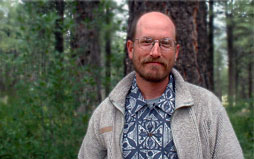Global warming is speeding up the mortality of trees, and NAU research is providing some of the data to prove it.
Pete Fulé, an NAU associate professor in the School of Forestry and a director of the university’s Ecological Restoration Institute, is a coauthor of “Widespread Increase of Tree Mortality Rates in the Western United States,” an article to be published in the Jan. 23 issue of Science journal.
The study, led by principal authors Phillip J. van Mantgem and Nathan L. Stephenson, scientists with the Western Ecological Research Center for the U.S. Geological Survey in northern California, “offers data to show that there is a problem with tree mortality in the West and that climate is an important element in the problem,” Fulé explained.
Eleven scientists contributed to the study by providing long-term data sets taken from trees across the Pacific Northwest, California, Idaho, Colorado and Arizona. The article concludes that tree death rates have more than doubled in recent decades in otherwise undisturbed old forests—largely a consequence of regional warming.
“The gist is that we now have these long-term data sets from old trees across much of the western part of the country and one thing those forests have in common is that the trees are dying increasingly fast,” Fulé said.
To determine when trees died as a result of climate change, scientists documented climate-related incidents that caused trees to die, such as bark beetle attacks or forest fires.
Fulé worked with NAU researchers to provide tree measurements from more than 6,000 trees, mostly ponderosa pines, rooted in the Gus Pearson Natural Area established in 1908 and located within the Fort Valley Experimental Forest 12 miles north of Flagstaff. Trees in the experimental forest can reach beyond 500 years old.
The study, conducted in conjunction with the Ecological Restoration Institute, the School of Forestry and the U.S. Forest Service Rocky Mountain Research Station, analyzed tree measurements dating back to the 1920s. Fulé and other NAU researchers also updated the data by revisiting trees and providing current measurements and codes for environmental occurrences.
“Despite the impact of warming climate, in the Southwest we have an opportunity to lower tree mortality rates by thinning forests and restoring surface fires,” Fulé said. “There is strong empirical evidence that these actions improve the resilience of trees to drought and insect pathogens, and protect them from severe stand-replacing wildfires.”
Fulé, a big believer in thinning forests to protect the vigor of old growth trees and produce biomass fuels, admits the study is a “gloomy predictor of the future, but we still have the option of making a practical difference with forest management,” he said. “If climate change is going to change vegetation, we can at least be thinking about what is coming next and how to manage it.”
The American Association for the Advancement of Science publishes the international weekly Science journal. For information, go to sciencemag.org/current.dtl.



